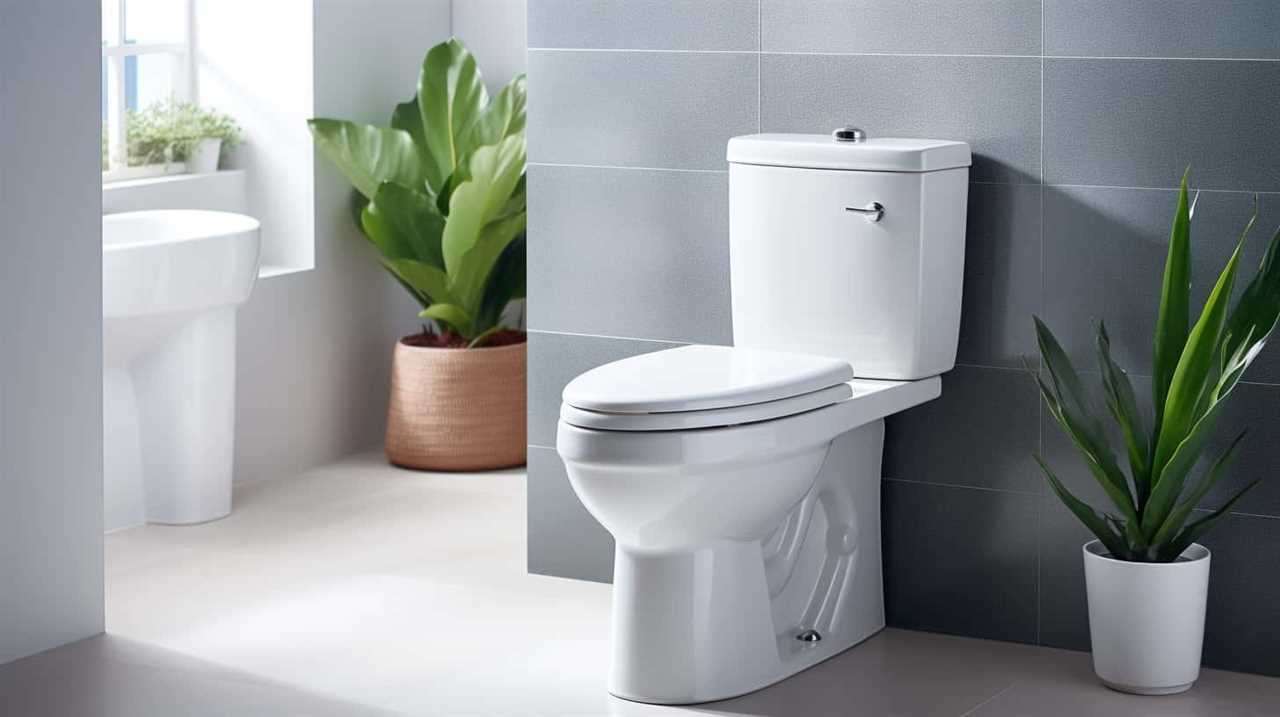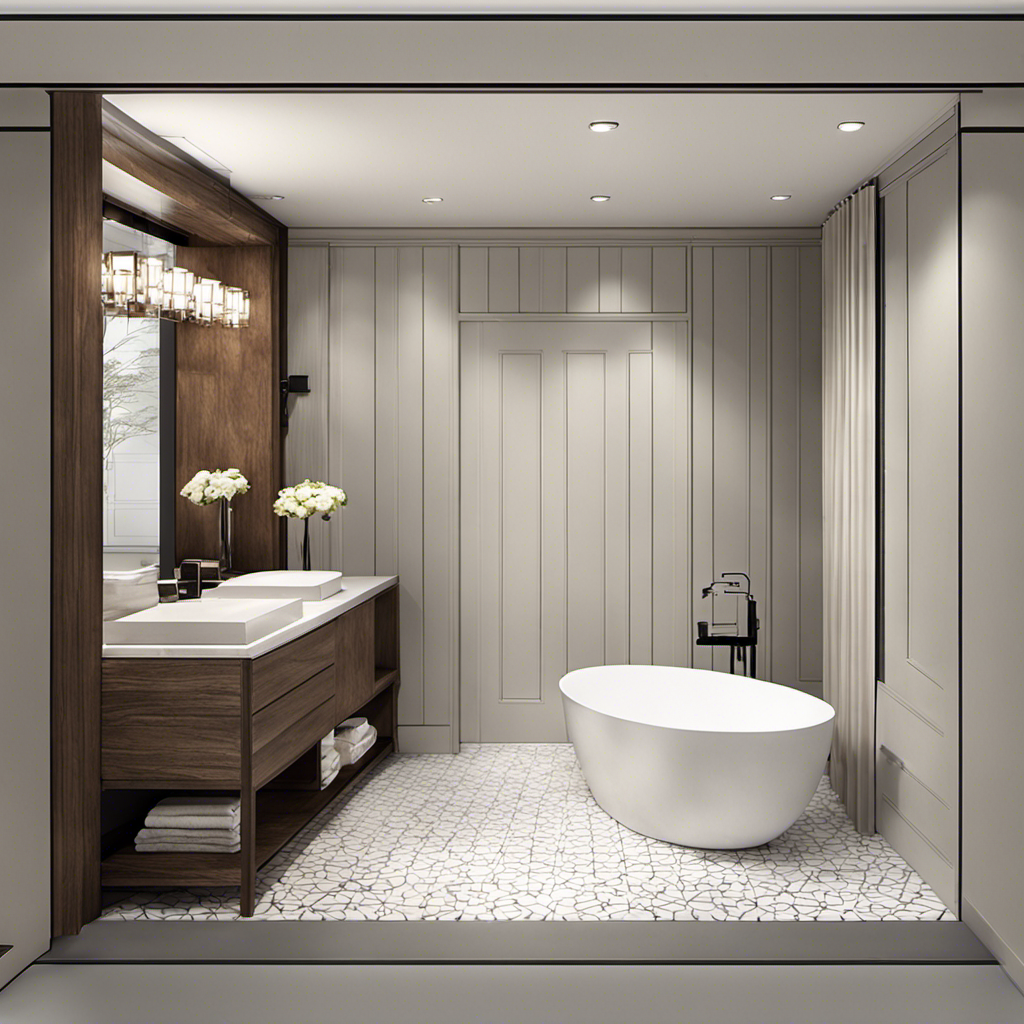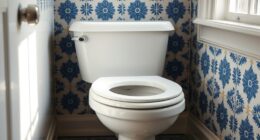Understanding your toilet’s rough-in size is key to ensuring a proper fit with your bathroom plumbing. Measure from the wall behind the toilet to the center of the drainpipe, as most toilets are designed for a 12-inch rough-in, though 10 or 14 inches are also available. Correct measurement helps avoid costly modifications or reinstallation issues. Keep exploring to learn more tips on selecting and measuring the right rough-in size for your bathroom.
Key Takeaways
- Measure from the wall behind the toilet to the center of the drainpipe to determine the rough-in size.
- Most residential toilets are designed for a standard 12-inch rough-in, but 10-inch and 14-inch options exist.
- Accurate measurement ensures compatibility with existing plumbing and prevents costly modifications.
- Verify your bathroom’s rough-in size before purchasing to avoid installation delays or the need for adjustments.
- Non-standard rough-in sizes may require custom solutions or specific toilet models for proper fit.

When installing a new toilet, understanding the rough-in size is vital for guaranteeing a proper fit. This measurement determines how well your toilet will sit against the wall and how smoothly your bathroom renovation progresses. Getting the wrong rough-in size can lead to unnecessary delays, extra costs, and even the need to replace the toilet after installation. To avoid these issues, you need to be familiar with standard plumbing standards and how they influence rough-in measurements. Most toilets are designed to fit standard rough-in sizes, which are typically 12 inches, but 10-inch and 14-inch options also exist. Before purchasing a new toilet, you should measure the distance from the wall behind the toilet to the center of the drainpipe. This measurement is your rough-in size. Guaranteeing accurate measurement is vital because it guarantees that the toilet will align with the plumbing and fit within your bathroom space without requiring modifications. When planning a bathroom renovation, you want to select a toilet that matches your existing rough-in to avoid costly adjustments or reconfigurations. Understanding plumbing standards helps in choosing the right toilet. Most residential properties follow the common 12-inch rough-in standard, but older homes or specific bathroom layouts may have different measurements. If your rough-in size doesn’t match standard options, you might need a custom solution or a different model designed for non-standard measurements. Always verify your rough-in size before buying, especially if you’re upgrading or replacing an existing toilet. This step guarantees compatibility, saves time, and minimizes surprises during installation. Proper measurement becomes even more vital when you’re undertaking a bathroom renovation. The goal is to create a seamless, functional space, and selecting a toilet with the correct rough-in size is part of that process. If you ignore the importance of plumbing standards and measurements, you risk ending up with a toilet that doesn’t fit, leading to potential leaks, instability, or the need for additional modifications. Remember that some toilets are adjustable or come with elongated or round bowls, but the rough-in size remains a fixed measurement. Additionally, understanding the role of contrast ratio can help in selecting a toilet with suitable visual clarity and lighting, especially in dimly lit bathrooms.
Frequently Asked Questions
Can Rough-In Sizes Vary Between Toilet Models?
Yes, rough-in sizes can vary between toilet models. You should check rough-in standards for each model to guarantee toilet compatibility. Different manufacturers might have slight variations, so measuring your existing setup accurately is important. Always compare the rough-in dimension specified by the toilet manufacturer with your bathroom’s rough-in to avoid installation issues. This way, you ensure a proper fit and smooth installation process.
How Do I Measure for a Custom Rough-In?
Measuring for a custom rough-in might seem tricky, but you can master it with simple measurement techniques. First, measure the rough-in dimensions by carefully measuring from the wall behind the toilet to the center of the drain pipe. Use a tape measure for accuracy and double-check your data. Clear, consistent measurements help guarantee you select a toilet that fits perfectly, preventing plumbing problems and promoting proper posture.
Are There Universal Rough-In Sizes for All Bathrooms?
You wonder if universal rough-in sizes exist for all bathrooms. While some toilets follow standard plumbing standards, most have specific toilet dimensions, typically 12 inches, but can range from 10 to 14 inches. It’s essential to measure your rough-in precisely to guarantee proper fit. Don’t assume a universal size; always check your bathroom’s plumbing standards and rough-in measurement before choosing a new toilet.
What Are the Signs of an Incorrect Rough-In Installation?
Imagine your bathroom as a stage, and the toilet’s rough-in measurement as the script. If the installation errors happen, the toilet might wobble like a dancer missing a cue or sit unevenly, making it clear something’s off. Signs of incorrect rough-in installation include leaks, cracks around the base, or difficulty fitting the toilet. These issues point to a mismatch or misjudged rough-in measurement, disrupting your bathroom’s harmony.
Can I Modify My Existing Rough-In to Fit a Different Toilet?
Yes, you can modify your existing rough-in to fit a different toilet, but it depends on your toilet’s compatibility and installation flexibility. You might need to move the flange or adjust the distance between the bolts. However, it is crucial to measure carefully and consider professional help to guarantee a proper fit. Sometimes, upgrading the rough-in is more straightforward, especially if your new toilet’s rough-in size differs considerably.
Conclusion
Understanding toilet rough-in sizes might seem like a small detail, but it’s the key to a perfect fit. When you measure correctly, you’re not just choosing a toilet — you’re setting the stage for comfort and peace of mind. Think of it as finding the missing piece of a puzzle; once it clicks into place, everything feels right. So, take your time, measure carefully, and enjoy the satisfaction of a job well done.










